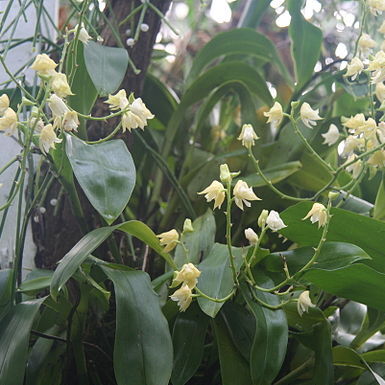Herbs epiphytic, lithophytic, or terrestrial. Roots velamentous. Stems slender or pseudobulbous, clustered or distant along rhizome. Leaves 1–several, conduplicate, thin [fleshy], leathery. Inflorescences terminal, simple or paniculate racemes with ± secund branches; peduncle enclosed by scarious sheaths. Flowers few to many, mostly not resupinate, generally small; dorsal sepal free; lateral sepals adnate to column foot forming mentum; petals smaller than sepals, free; lip 3-lobed [simple], adnate to and articulate with column foot, forming part of mentum; disc usually callose, pubescent; column semiterete, short; foot distinct; stigmas confluent, transverse under rostellum, viscidium ovate to elliptic; anther terminal, incumbent, operculate; pollinia 4, globose or ellipsoid, hard, waxy, attached to single short stipe. Fruits capsules.
Herbs, epiphytic or lithophytic. Stem erect, often pseudobulbous or fusiform, simple or superposed, with 1 to several leaves. Leaves conduplicate, often narrowly oblong or oblong, sheathing and articulate at base. Inflorescences terminal, racemose or paniculate, few to many flowered; peduncle often enclosed in scarious sheaths. Flowers not resupinate, small or sometimes medium-sized. Sepals connivent or spreading; dorsal sepal free; lateral sepals adnate to column foot forming a mentum. Petals smaller, usually linear; lip superior, entire or 3-lobed, base articulate with column foot, spurless; disk often farinaceous (pseudopollen). Column short, with conspicuous column foot; pollinia 4 (unequal in size, in 2 pairs) or 2 (each deeply cleft), waxy, with a small stipe and a viscidium.
Epiphytic or rarely terrestrial, caespitose, pseudobulbose (Panamanian species) herbs. Inflorescence a raceme or panicle. Dorsal sepal free. Lateral sepals larger than the dorsal, forming a mentum at their bases. Petals much smaller than the sepals, usually linear. Lip non-resupinate, nearly entire or usually 3-lobed; disc of the lip usually with a conspicuous callus and often covered with fragile, artic-ulated or farinaceous cells. Column short, with a prominent foot; pollinia 4, or 4 joined into 2.
Column porrect, usually short and stout with a ± elongate foot; pollinia 2, ovoid; stipe 1, square or sub-triangular to oblong or linear; viscidium small to large, round or ellipsoid; rostellum usually obscure, bifid in front, rarely slightly elongated or beak-like.
Stems usually forming pseudobulbs, clustered or less commonly spaced out on a creeping rhizome, sometimes branched or superposed (emerging from nodes above the base of the previous pseudobulb), 1-to several-noded, with 1 to several leaves.
Lip usually 3-lobed but sometimes entire, with or without a basal callus, glabrous, pubescent or farinose, often recurved, sometimes fleshy and difficult to flatten without breaking.
Flowers usually non-resupinate, very small or medium-sized, rarely large, usually fragrant, often pubescent, green, yellow, white, pink, mauve or orange, rarely red.
Floral bracts erect to reflexed, setiform, lanceolate, ovate or obovate, acute or acuminate to mucronate.
Dorsal sepal lanceolate to ovate; lateral sepals ± oblique, joined to the column-foot to form a mentum.
Inflorescence (comprising peduncle, rhachis and flowers) 1-to many-flowered, simple or branching.
Leaves linear, lanceolate, oblanceolate or elliptic, varying in texture.
Epiphytic, occasionally lithophytic or terrestrial perennial herbs.
Petals linear to obovate.

